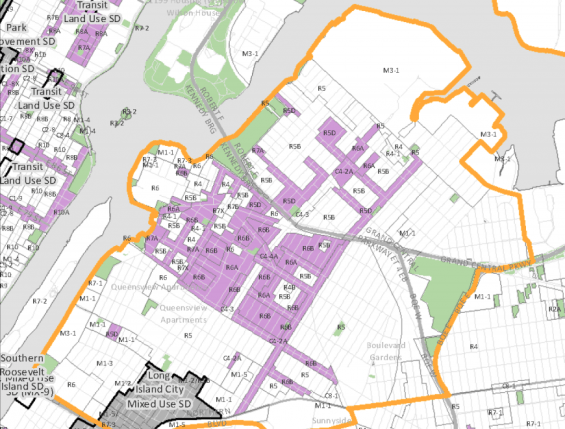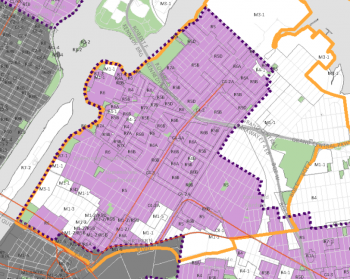
Shaded areas: maximum building height would be increased 5′
Sept. 28, 2015 By Jackie Strawbridge
A City proposal that would lead to taller buildings and reduced parking in Astoria will be presented to local leaders by the Department of City Planning next week.
DCP is proposing two amendments to the City’s Zoning Resolution, which the agency believes will promote affordable housing and higher-quality buildings City-wide. A presentation is scheduled for Community Board 1’s Zoning and Variance Committee on Sept. 29 at 6:30 at the CB 1 office, 45-02 Ditmars Blvd.
One amendment, called Zoning for Quality and Affordability, involves a slew of modifications to current zoning regulations that DCP considers outdated and restrictive. The modifications most relevant to Astoria will involve building height and parking requirements.
Within a large swath of Astoria, residential buildings would be allowed to stretch five feet higher than current regulations allow.
As described in DCP documents, the height increase is intended to give builders more flexibility within existing zoning rules, to encourage new housing construction with more engaging architecture.
Similar tweaks to zoning rules would incentivize affordable senior housing in the neighborhood.
Developers who build affordable senior homes along Steinway Street, in central Astoria and in a portion of Ditmars, could build 10 or 20 feet higher than currently allowed, depending on zoning district. In a wider chunk of the district, certain types of senior housing and long term care facilities would also be allowed greater height and floor area.
John Carusone, chair of CB 1’s Zoning and Variance committee, said, “I think everybody is in favor of affordable housing, that’s not the issue. The issue is: at what cost?”
“You increase density, you increase all kinds of other problems,” he continued, specifically citing infrastructure and traffic. “[We want to know] whether these incentives they are presenting to promote housing will affect the quality of life of the existing neighborhood.”
“The goals of quality and affordability are complementary: it is essential that we achieve both,” DCP Chairman Carl Weisbrod said in a statement. “[These changes] will address longstanding concerns about our zoning rules to help make the City more affordable to a wide range of New Yorkers, and foster diverse, livable communities with buildings that contribute to the character and quality of neighborhoods.”
Another zoning change that would affect almost the entirety of Astoria would be the elimination of parking requirements at affordable and senior housing.

Shaded area: where parking requirements would be eliminated for affordable and senior housing
DCP argues that in areas such as Astoria, where public transportation is available, low-income households own fewer cars and the off-street parking provided to them goes to waste.
By removing the requirement, DCP said, it will remove an unnecessary cost to affordable housing developers.
The proposal inspired significant skepticism from Queens’ Community Board chairs in April when it was presented to the Queens Borough Board.
Bob Piazza, chair of CB 1’s Transportation Committee, said he would wait until after next week’s committee meeting to comment in depth on the plan, but noted “strong reservations” about the elimination of the off-street parking requirements.
DCP’s other zoning amendment, called Mandatory Inclusionary Housing, would require that new developments of more than 10 units include 25 or 30 percent permanently affordable housing when a rezoning to increase housing capacity occurs.
Therefore, if a private developer built a residential tower in Astoria, and asked the City for a rezoning of the property to permit construction of more units, MIH would be triggered.
Next week’s committee meeting is part of a six-month public review period that kicked off on Monday.
“After we hear [DCP’s presentation] we’ll start forming our own recommendations for what we’d like to see,” Carusone said.
4 Comments

Q – How many developers does it take to buy off a city planner ?
Talk about something we do not need in Astoria !!! I am all for low income senior housing but I have a hot news flash for you – we still drive and need parking. As for the 5 additional feet – that can spell disaster on some blocks!!
Looking forward to all the massive development and strain on our infrastructure.
Great job writing an objective article. Bravo journalistic principles.
How does one get a job on the Community Planning Board; how much does it pay? Just what is needed more cars and less parking in Astoria. Oh, I forgot “low-income households own fewer cars and the off-street parking provided to them goes to waste”. How many low income households can afford 2 grand a month? Really!